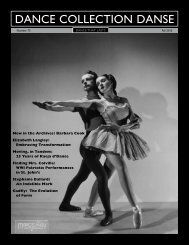DANCE COLLECTION DANSE
3E8Oe3fJp
3E8Oe3fJp
Create successful ePaper yourself
Turn your PDF publications into a flip-book with our unique Google optimized e-Paper software.
School of Contemporary Dancers 2003 graduating students<br />
Kevin Côté, Emma Doran, Zach Schnitzer, Allison Wersch and<br />
Brooke Noble in Stephanie Ballard’s Prairie Song (1980)<br />
Photo: Rodney Braun<br />
States in 1976, Ballard became Spohr’s go-to dinner date<br />
and loyal friend. These personal relationships fostered<br />
an important network and planted roots that became<br />
integral to Ballard’s identity as an artist. She felt a strong<br />
spiritual connection to the city and, almost immediately,<br />
began identifying herself as being “from Winnipeg”.<br />
The year 1977 marks a significant turning point in<br />
Ballard’s career. In 1976, Montreal-based choreographer<br />
Linda Rabin began assembling dancers for a new<br />
project and needed mature artists for what she knew<br />
was going to be an experimental process. Rabin had first<br />
worked with Ballard when setting Domino on WCD in<br />
1974 and remembered her trusting and open approach<br />
to creation. Although Ballard was suffering from<br />
rheumatoid arthritis and had actually decided to stop<br />
dancing, she was assured by Rabin that only minimal<br />
exertion would be required. Already sensing the significance<br />
of the project, Ballard joined Rabin in Montreal.<br />
Since its first presentation, The White Goddess has been<br />
regarded as an event of mythic proportion. Based on Robert<br />
Graves’s book of the same name, the work pays homage<br />
to female consciousness and honours the concept of a<br />
great goddess, or feminine deity. Nestled in the zeitgeist<br />
of second-wave feminism, and more ceremony than<br />
dance, the work had a profound impact on many of those<br />
who experienced it. Ballard remembers that Toronto<br />
Dance Theatre co-founder Peter Randazzo was intensely<br />
affected by its performance at the 1977 Dance in Canada<br />
Association (DICA) Conference and was reduced to tears.<br />
For Ballard, the choreographic process of creating<br />
The White Goddess was transformative. Aside<br />
from the introduction to the unique artistic climate<br />
in Montreal and the formation of important friendships<br />
with artists Margie Gillis and Candace Loubert,<br />
Ballard was inspired by Rabin’s creation methods<br />
and instilled with a tremendous respect and curiosity<br />
for artistic process. She returned to Winnipeg<br />
consumed with her own creative energy.<br />
The spark of Ballard’s choreographic notions was<br />
well timed. By then, Browne had initiated a series of<br />
choreographic workshops for the company, and dancer<br />
Joost Pelt had spearheaded a Dance Discovery workshop<br />
performance series. Ballard also received a grant<br />
that provided her with a year’s worth of living expenses<br />
and the opportunity to study the choreographic process<br />
by observing the work of David Earle, Lynne Taylor-<br />
Corbett and Norman Morris, among others. The late<br />
1970s saw the birth of her first choreographies, including<br />
Mahler Duet (1977), Sympathetic Magic (1979) and<br />
her first full-length choreography, In Passing (1978).<br />
In 1979 Ballard was appointed artistic director and<br />
manager of WCD’s apprentice program. This afforded<br />
her more opportunities to flex her choreographic<br />
muscles, and soon WCD’s repertoire contained three<br />
of Ballard’s choreographies: Construction Company,<br />
Snow Goose and her signature piece, Prairie Song.<br />
Ballard has said that Prairie Song was created out of<br />
a “need and desire to explore the mysteries of isolation.”<br />
Having experienced nearly a decade of prairie<br />
winters, Ballard was inspired by the stories of her<br />
friends’ ancestors – many of whom had lived on the<br />
Prairies for generations. Filled with a respect for one’s<br />
ability to survive in such a rough and remote environment<br />
in the pioneer age, Ballard created a work that<br />
touches on the solitude, and almost madness, of five<br />
individuals who are seemingly disconnected from<br />
each other. In an indication of the company’s faith in<br />
Ballard’s merit as a choreographer, WCD was represented<br />
by Prairie Song at the prestigious Canadian Dance<br />
Spectacular at Ottawa’s National Arts Centre in 1980.<br />
Prairie Song was followed by an ambitious rendition of<br />
A Christmas Carol (1981), which attempted to shed light on<br />
the social conditions surrounding the novel, and Time Out<br />
(1982) – an exploration of the relationship between Zelda<br />
and F. Scott Fitzgerald. Ballard was also commissioned to<br />
choreograph and perform for Mother Theresa during her<br />
1982 visit to Winnipeg – an experience that Ballard<br />
remembers as one of the most rewarding of her career.<br />
At the end of 1982, journalist/dance critic Robert<br />
Enright wrote in Dance in Canada magazine that the<br />
choreographic trinity of Browne as artistic director,<br />
Ballard as associate artistic director, and Tedd Robinson<br />
as resident choreographer at WCD, was a “potent force”.<br />
However, the promising partnership was not meant to<br />
be. Although Browne was a mentor and friend to many,<br />
some company and board members were reportedly<br />
dissatisfied with her leadership, and in a now notorious<br />
coup, Browne was ultimately asked to resign as director.<br />
34 Dance Collection Danse




